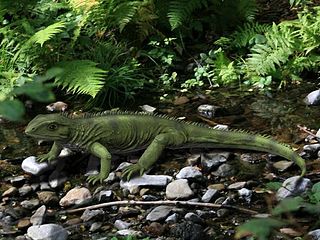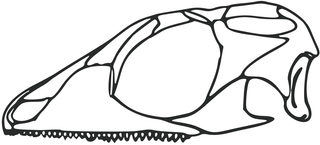
Rhynchocephalia is an order of lizard-like reptiles that includes only one living species, the tuatara of New Zealand. Despite its current lack of diversity, during the Mesozoic rhynchocephalians were a speciose group with high morphological and ecological diversity. The oldest record of the group is dated to the Middle Triassic around 238 to 240 million years ago, and they had achieved a worldwide distribution by the Early Jurassic. Most rhynchocephalians belong to the group Sphenodontia ('wedge-teeth'). Their closest living relatives are lizards and snakes in the order Squamata, with the two orders being grouped together in the superorder Lepidosauria.

Melanorosaurus is a genus of basal sauropodomorph dinosaur that lived during the Late Triassic period. A herbivore from South Africa, it had a large body and sturdy limbs, suggesting it moved about on all fours. Its limb bones were massive and heavy like the limb bones of true sauropods.

Elachistosuchus is an extinct genus of neodiapsid reptile, most likely basal archosauromorph, known from the Late Triassic Arnstadt Formation of Saxony-Anhalt, central Germany. It contains a single species, Elachistosuchus huenei, known from a single individual E. huenei, originally considered a pseudosuchian archosaur and then a rhynchocephalian lepidosaur, was largely ignored in the scientific literature, as its small size and fragility did not permit further mechanical preparation and examination. More recently however, a non-invasive μCT scanning was performed to resolve its placement within Reptilia, and found it to represent a more basal reptile, potentially closely related to several early archosauromorph clades.

Macrocnemus is an extinct genus of archosauromorph reptile known from the Middle Triassic of Europe and China. Macrocnemus is a member of the Tanystropheidae family and includes three species. Macrocnemus bassanii, the first species to be named and described, is known from the Besano Formation and adjacent paleontological sites in the Italian and Swiss Alps. Macrocnemus fuyuanensis, on the other hand, is known from the Zhuganpo Formation in southern China. A third species, Macrocnemus obristi, is known from the Prosanto Formation of Switzerland and is characterized by gracile limbs. The name Macrocnemus is Greek for "long tibia".

Ticinepomis is an extinct genus of coelacanth lobe-finned fish which lived during the Middle Triassic period in what is now Switzerland. It contains two species, T. peyeri and T. ducanensis.

Clevosaurus is an extinct genus of rhynchocephalian reptile from the Late Triassic and the Early Jurassic periods. Species of Clevosaurus were widespread across Pangaea, and have been found on all continents except Australia and Antarctica. Five species of Clevosaurus have been found in ancient fissure fill deposits in south-west England and Wales, alongside other sphenodontians, early mammals and dinosaurs. In regards to its Pangaean distribution, C. hadroprodon is the oldest record of a sphenodontian from Gondwana, though its affinity to Clevosaurus has been questioned.

Diphydontosaurus is an extinct genus of small rhynchocephalian reptile from the Late Triassic of Europe. It is the most primitive known member of Sphenodontia.

Gephyrosauridae is an extinct family of rhynchocephalians that lived in the Late Triassic and Early Jurassic. They are generally considered to be rhynchocephalians that lie outside of Sphenodontia, but in some analyses they are recovered as more closely related to squamates than to sphenodontians.

Gephyrosaurus is a genus of early rhynchocephalian first described and named in 1980 by Susan E. Evans. They are distantly related to the extant Sphenodon with which they shared a number of skeletal features including a large tooth row along the side of the palatine bone and posterior process of the dentary bone. The type species, G. bridensis, lived during Early Jurassic in Wales, UK. Whiteside & Duffin (2017) described the second species, G. evansae, known from a partial maxilla recovered from Late Triassic (Rhaetian) fissure fills in Carboniferous Limestone in Somerset. Gephyrosaurus, other potential gephyrosaurids and Wirtembergia are the only rhynchocephalians to lie outside Sphenodontia in modern definitions of the group, and have been found to be more closely related to squamates in some phylogenetic analyses.

Sphenotitan is an extinct genus of rhynchocephalian reptile, known from the Late Triassic (Norian) Quebrada del Barro Formation of Argentina. It is the earliest known member of the herbivorous Elienodontinae, and the only one known from the Triassic. It was a large-sized sphenodontian, with an estimated skull length of over 10 centimetres (3.9 in). The skull is roughly triangular in shape, and had large upper temporal fenestrae. The region of the skull in front of the eye socket is short. The premaxillae forms beak, with a cutting edge similar to a chisel. The teeth of Sphenotitan, like other elienodontines, were large and wide, and designed for shredding vegetation, with blade-like palatal teeth on the roof of the mouth.

Opisthodontia is a proposed clade of sphenodontian reptiles, uniting Opisthias from the Late Jurassic-earliest Cretaceous of Europe and North America with the Eilenodontinae, a group of herbivorous sphenodontians known from the Late Triassic to Late Cretaceous.
Palacrodon is an extinct genus of Triassic reptile with a widespread distribution. It was initially described from teeth collected in Early Triassic deposits in South Africa, and later reported from the Early Triassic of Antarctica and the Late Triassic of Arizona. Although previously considered an early rhynchocephalian, it is currently considered to be a non-saurian neodiapsid.

Clevosaurs are an extinct group of rhynchocephalian reptiles from the Triassic and Jurassic periods.

Colobops is a genus of reptile from the Late Triassic of Connecticut. Only known from a tiny skull, this reptile has been interpreted to possess skull attachments for very strong jaw muscles. This may have given it a very strong bite, despite its small size. However, under some interpretations of the CT scan data, Colobops's bite force may not have been unusual compared to other reptiles. The generic name, Colobops, is a combination of κολοβός, meaning shortened, and ὤψ, meaning face. This translation, "shortened face", refers to its short and triangular skull. Colobops is known from a single species, Colobops noviportensis. The specific name, noviportensis, is a latinization of New Haven, the name of both the geological setting of its discovery as well as a nearby large city. The phylogenetic relations of Colobops are controversial. Its skull shares many features with those of the group Rhynchosauria, herbivorous archosauromorphs distantly related to crocodilians and dinosaurs. However, many of these features also resemble the skulls of the group Rhynchocephalia, an ancient order of reptiles including the modern tuatara, Sphenodon. Although rhynchosaurs and rhynchocephalians are not closely related and have many differences in the skeleton as a whole, their skulls are remarkably similar. As Colobops is only known from a skull, it is not certain which one of these groups it belonged to. Pritchard et al. (2018) interpreted it as a basal rhynchosaur, while Scheyer et al. (2020) reinterpreted it as a rhynchocephalian.
The Klettgau Formation is a geological formation in Switzerland. It is Late Triassic in age, covering most of the mid to late Norian, the Carnian, and into the Rhaetian, spanning a period of 26-30 million years.
The Avon Fissure Fill, also known as the Bristol Fissure Fill or Tytherington Fissure Fill, is a fissure fill in Avon, England which dates variously from the Norian and Rhaetian stages of the Late Triassic, or possibly as late as the Hettangian stage of the Early Jurassic. The fissure fill at Avon was a sinkhole formed by the dissolution of Lower Carboniferous limestones.
Lanceirosphenodon is an extinct genus of sphenodontian from the Late Triassic Candelária Formation of Brazil. It contains a single species, Lanceirosphenodon ferigoloi.
Fraserosphenodon is an extinct genus of sphenodontian from the Late Triassic of the United Kingdom. It contains a single species, Fraserosphenodon latidens.
Penegephyrosaurus is an extinct genus of early rhynchocephalian from the Late Triassic of the United Kingdom. It contains a single species, Penegephyrosaurus curtiscoppi.
Pelecymala is an extinct genus of sphenodontian reptile that lived in southwest England during the Triassic period. It has been recovered in recent studies as a primitive member of the group.












